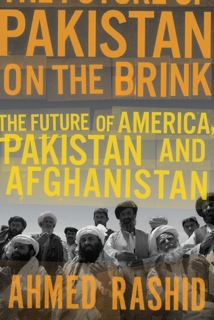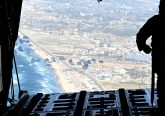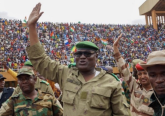 Ahmed Rashid, the veteran Pakistani writer on the conflict in Afghanistan and Central Asia, has authored another book, titled Pakistan on the Brink: The Future of America, Pakistan and Afghanistan. A sequel to his four earlier books on the subject since mid-90s, especially Descent into Chaos (2008), the study underlines the precariousness of the Pakistani state’s chances for survival and the urgent need for policy resolutions. It also explains the causes of the recent deterioration in US-Pakistan relations and how they can be rectified; pinpoints factors responsible for the failure of the Obama Administration’s approach towards Pakistan and the Afghan war; and suggests ways to stabilise Pakistan and achieve a lasting peace in Afghanistan, amid the withdrawal of US and NATO troops from the war-torn country by 2014.
Ahmed Rashid, the veteran Pakistani writer on the conflict in Afghanistan and Central Asia, has authored another book, titled Pakistan on the Brink: The Future of America, Pakistan and Afghanistan. A sequel to his four earlier books on the subject since mid-90s, especially Descent into Chaos (2008), the study underlines the precariousness of the Pakistani state’s chances for survival and the urgent need for policy resolutions. It also explains the causes of the recent deterioration in US-Pakistan relations and how they can be rectified; pinpoints factors responsible for the failure of the Obama Administration’s approach towards Pakistan and the Afghan war; and suggests ways to stabilise Pakistan and achieve a lasting peace in Afghanistan, amid the withdrawal of US and NATO troops from the war-torn country by 2014.
The 238-page book published by Allen Lane is divided into nine chapters and reads like a collection of essays. It can be “opened anywhere, and any chapter can be read separately from the rest” (xix), as the author writes in preface. However, precisely because of the same reason, the book is too often repetitive, with overlapping sections, for instance, about Pakistan’s quagmire and its deteriorating ties with America. Much of the narrative is descriptive and about events in recent years. While the author covers an array of topics related to the main themes of his work, some of his substantive arguments are as follows:
Principal Contentions
The crisis in Pakistan: Pakistan is “the most unstable country and the most vulnerable to terrorist violence, political change, or economic collapse. Its multiple long-term and short-term challenges seem insurmountable by the present military and civilian leadership. It is not a failed state, but as its fragile state worsens, it is sliding down the path of becoming one” (pp.11-12). These challenges include the worsening security quagmire caused by Taliban terrorism and ethno-sectarian strife, as well as rampant political corruption, inefficient governance, and a crumbling economy unable to meet the growing needs of a burgeoning population with significant youth bugle.
Pakistan’s current crisis is rooted in its elite’s failure to establish a coherent national identity, its army’s pursuit of an India-centric national security paradigm, and “the inability of its ethnic groups to find a workable political balance with one another” (p.28). But, ultimately, it is the “army’s continued reliance on proxy jihadi forces” to realise regional security objectives which is at “the heart of the country’s rapid decline, its worsening relations with the West and neighbouring countries, and its image as the centre of global terrorism”(p.46).
“Unless both the military and the political parties put change and reform on the agenda, Pakistan will face a loss of political control, growing anarchy and violence in the provinces and among ethnic groups, enormous catastrophe for tens of millions of people, natural disasters made worse by lack of government, and the ever looming threat of militant Islam. Most critical of all for a country whose army guards its nuclear weapons arsenal, potential coup makers in the ranks, linked to the extremist political parties outside, may threaten the army’s cohesion and unity. Pakistan poses a much more dangerous situation than even Afghanistan”(p. 207).
US-Pakistan Breakdown: American-Pakistani relations have deteriorated to the “just short of war” situation. This deterioration predates the episode of Osama bin Laden’s killing in Pakistan, and is due to the failure of both countries and their leaders for institutionalizing meaningful security and economic cooperation. Since 2001, two US administrations have ignored Pakistan’s growing domestic problem. “Neither Bush nor, it seems, Obama has had a strategic vision sufficiently broad to persuade Pakistan to shut down sanctuaries and refocus its strategy” (p.21).
For its part, Pakistan has also failed “to address the extremist threat,” despite constant US demands and pressures since 2001. Moreover, its state functionaries through pliable media have whipped up anti-Americanism by “constantly feeding false narratives about the US, along with India and Israel, “conspiring” to “ultimately dismember Pakistan” and capture “Pakistan’s nuclear weapons” (pp.33-34). These narratives have helped divert Pakistani public’s attention on the issue of Osama bin Laden from the army’s incompetence or culpability to the violation of Pakistani sovereignty by the US.
US failure in Afghanistan: The Obama Administration has failed to “develop a comprehensive political strategy in Afghanistan that the US military could not delay or even hold hostage” (p.90). The Pentagon and the CIA have, consequently, gained autonomy in conducting counter-insurgency and counter-terrorism operations, including drone strikes in Pakistan and night raids in Afghanistan, which are hugely counter-productive. The US military and intelligence also prefer to pursue the military course in Afghanistan and resent the option of making peace with the Taliban.
However, since the “West can no longer afford to fight in Afghanistan” (p.17), the “faster the United States talks to the Taliban and works out a peaceful settlement that will allow the [US and NATO] troops to depart in good order, the better it will be, both for the United States and the region”(p.112). “Most Afghans want US troops to leave but are divided between wanting a peace settlement and wanting to share power with the Taliban” (p.15). The option of integrating insurgents in Afghan society will not work until their leaders are reconciled. As for the logic and morality of making peace with the enemy, the Taliban “have matured considerably since the 1990s” (p.117), and they do not share al-Qaeda’s global agenda. The Taliban have also “mellowed on the issues of girls’ education, the media, and health services for women”(p.117).
The Way Forward: “A positive outcome for the region will depend on a deliberate, carefully considered Western withdrawal from Afghanistan, the existence of a political settlement with the Taliban, and Pakistan’s willingness to rein in Islamic extremism and prevent a potential state meltdown”(p.189) “The United States has to get its strategy right and share with its allies. It must clarify what relationship it wants to have with Afghanistan, Pakistan, and the wider region after its withdrawal in 2014. It must push forward for a comprehensive dialogue with the Taliban…It must build a more stable relationship with Pakistan” (p.207).
Peace making with the Taliban must include in the beginning “confidence-building measures, to reduce the unacceptably high levels of violence emanating from the conflict”(p.208). The CMBs, such as a Taliban halt in political assassinations in exchange for the US abandoning night raids, and mutually-agreed ceasefires bound by space and time, can lead to “longer-lasting measures” that actually bring violence down on a permanent basis”(p.209).

Pakistan has to stop making distinctions “between good Taliban and bad Taliban, good extremists and bad, those who fight Pakistani forces and those who do not.” It is equally vital that “Pakistan change its attitude towards the region” (p.193);” otherwise, it will be left out the peace process. “It must not be permitted to make decisions that are detached from global and regional realities”(p.194). The country’s “internal conundrum of military versus civilian power must be slowly resolved in favour of civilian, but civilian politicians must be much more responsible to the nation than they have been so far”(p.210). Stable Pakistan requires an uninterrupted process of democratization, through successive elections and civilian governments in future.
Critical Observations
Ahmed Rashid has a distinction of logically interpreting currently evolving events in the region and offering a persuasive perspective on their root-causes and potential outcomes. Like his earlier works, Pakistan on the Brink has brought to the fore scores of issues crucial to Pakistan’s stability and Afghanistan’s peace, which deserve serious attention but are, nonetheless, debatable. Four critical points are worth mentioning:
First, the author’s present study is anti-thesis of his most popular 2000 book, Taliban: Militant Islam, Fundamentalism, and Oil in Central Asia, in which he had criticised the Clinton Administration for being obsessed with Osama bin Laden or Al-Qaeda and ignoring the real threat to international security from the Taliban movement and their extremist ambitions in and beyond Afghanistan. The neoconservative Bush administration draw the wrong conclusion from Taliban’s portrayal as a monster on the eve of 9/11, thereby treating them and Al-Qaeda as synonymous, rather than recognise inherent differences between the two movement’s extremist ideology and objectives. Thus, a war that was avoidable has been waged for the past over a decade, with horrendous humanitarian consequences for Afghanistan and Pakistan. It is only recently that alternative perspectives—such as An Enemy We Created by Linschoten and Kuehn—have emerged on the subject, to which Rashid also seems to subscribe now.
Second, the case the author seems to build for Afghan reconciliation is largely in tune with the on-going withdrawal of US and NATO forces from Afghanistan. What if factors such as economic recession and public disapproval had not emerged as major constraints to the involvement of the US and its Western allies in the Afghan war! Would the author still have supported dialogue with the Taliban, as intensely as his Western counterparts like Jonathan Steele (Ghosts of Afghanistan: The Haunted Battlefield) have done recently. The mantra of war over a decade ago has quickly transformed into a clarion call for peace. That in the process thousands died and millions were displaced doesn’t matter. Considering Western preferences in a regional conflict as central, and expecting local nations and people most affected by this conflict to reshape their priorities accordingly—for war at one time and for peace at another—is symptomatic of an imperial approach. Rashid talks about Taliban motivations without covering their movement from within and, instead, taking sides in the conflict as advisor to the leaders of its state parties. Who can guarantee that a peace process grounded on Western military failure in Afghanistan will “prevent possible or renewed civil war”? By pursuing dialogue, the Taliban may only be buying time, awaiting the withdrawal of foreign forces and then settling scores with Kabul’s present rulers. Another long war, which the Taliban have not lost, may have fuelled their jihadi resolve and extremist mind-set even further. Given the unpredictability of Taliban’s real intensions, what we really need to know are the specific incentives and disincentives that can respectively persuade and dissuade them from renewing deadly ambitions against opponents and dissidents inside Afghanistan?
Third, while several factors are responsible for causing the conflict in Afghanistan and aggravating the crisis of Pakistan, the pivotal role of the United States and its Western allies in both cases cannot be overlooked. The author, for instance, conveniently ignores the deadly consequences of the US-sponsored jihad against the Soviet occupation of Afghanistan and American abandonment of the region in its aftermath. Agreed that the Pashtun tribes residing in Pakistan’s borderlands with Afghanistan “are receptive to radicalisation because of their history of poverty, underdevelopment, and religious conviction, and their constant state of rebellion to protect their rights” (p.390). But the tendency of these regions still acting as safe havens for Afghan insurgents and the continued presence of millions of Afghan refugees in Pakistan are also legacies of that Afghan jihad. And if the military and intelligence are at the “driver’s seat” of the US policy in Afghan, as the author suggests, then reckless ambition of imperial America is the real problem in Afghanistan.
What explains the spending of half a trillion dollars on a military campaign that was avoidable in the first place and has in the end ripped apart Afghanistan’s intricate ethno-political fabric? Rather than concentrating on the deeply rooted systemic causes of the conflict, he looks at the conduct of the leaders in office—late Richard Holbrooke is hailed as the architect of Obama administration’s policy of reconciliation with the Taliban and civilian assistance to Pakistan; President Obama is blamed for not taking due interest in the affairs of Afghanistan; and Hamid Karzai, the controversial Afghan leader, is expected to “heal Afghanistan’s ethnic, political and social divide.”
Likewise, the causes of Pakistan’s current plight, which are long-standing, cannot be simplified to what American and Pakistani leaders did or did not do after the terrorist events of 9/11. Interestingly, by serving US strategic interests in the region during and after the Cold War, Pakistan seems to have somehow emulated the American model with a plus—as its army and intelligence not just dominate foreign policy but also lead domestic politics. The lack of civilian supremacy in foreign affairs is an issue that haunts America and Pakistan equally. Thus, if the US remains engaged with Pakistan, with the Pentagon and the CIA playing a lead role in the process, it is difficult to imagine how the role of the army and the ISI will recede in Pakistan’s domestic politics and foreign policy.
A final critical observation about the book pertains to the scary scenario it sketches for the future of Pakistan. Its state failure, alongside that of Afghanistan, is termed as so consequential that advances made by the Middle East through the Arab Spring will be destroyed and Central Asia will emerge as “the next battleground for Al Qaeda and militant Islam.” There is no dearth of recent literature articulating a doomsday discourse on Pakistan, but Rashid has taken this narrative to the next level. Doubtlessly, some of the current signs in Pakistan are worrying. There are forces in the country that thrive on conflict, and they are sparing no opportunity to transform this conflict from regional enmity with India to global hostility with America. The military’s preponderance in politics is still the main hedge against democratization. Other internal problems, from ethnic violence to economic downturn, are also as severe as the author suggests. He correctly identifies the state-sponsored bid to spread conspiracy theories in society through pliable media anchors and propagandists as a major cause of widespread public self-delusion and a pivotal source of the spread of extremist ideology.
The factors that have prevented Pakistan’s emergences as a stable and cohesive state, especially the issues of identity and ethnicity, cannot disappear overnight. Many of Pakistan’s current problems originate from the circumstances surrounding the partition of India in 1947 and the sordid internal realities as they have evolved overtime. However, the notion that Pakistan “may well tip over the brink” (p.211) if it comes under another quasi-military is debatable, if history is any guide. In fact, military or quasi-military rules, including Zia and Musharraf regimes, proved relatively more stable internally as well as in terms of the country’s ties with the United States. That they sowed the seeds of future source of instability in Pakistan is, however, equally true. The Obama administration doubtlessly deserves the credit for its pioneering attempt to empower civilians in Pakistan—contrary to the traditional US approach of dealing with the military alone and, in the process, scuttling the growth of democracy. Perhaps it is this aspect of the new US approach towards Pakistan that has also unnerved its army, and may partly explain its inclination for hostility with America.
Not everything is worsening in Pakistan. Equally noticeable are some positive transformations under way in the country, which form the basis of a counter-narrative, such as the one offered by Maleeha Lodhi’s 2011 edited volume, Pakistan: Beyond the Crisis State. Multiple power centres, besides mainstream political parties, have emerged to challenge the military’s monopoly over state power. An assertive judiciary and a proactive civil society are two examples. The present government may be the first one since independence to complete a full five-year term. There is also relative respite in Taliban terrorism, interestingly synchronising with the souring of Pakistan’s ties with America. India and Pakistan have made significant strides in their peace process, especially in the field of bilateral trade. India’s approach towards Pakistan is also no more terrorism-centric. It even supports the option of dialogue with the Taliban, as the author himself suggests. Such new regional realities also deserve due scholarly attention. Finally, it may not be appropriate to draw lessons from the Arab Spring for Pakistan, as Rashid does, given the time-tested resolve of its nation to resist dictatorships and show resilience even in the face of a galloping state crisis.
The writer is Quaid-i-Azam Fellow at St. Antony’s College, University of Oxford.








1 Comment
Firstly, I must pay my sincere compliments to the critic Dr Ishtiaq for finding the gaps in the author Ahmed Rashid’s myopic narrative. This is not the first time that he has been critical of Pakistan and presented a doomsday scenario for his own motherland to make his pay masters happy. In all his writings and deliberations at different forums he has been bashing Pakistan and thrived. Had he been only balanced in his assessments I bet he would not have been invited ever to any of the forums or his creations had received such attention as they did being negatively disposed towards Pakistan.
Dr Ishtiaq rightly pointed out that the author failed to reflect on the genesis of the problems in Afghanistan that we see today. Let me add that the author also failed to reflect that India has been part of the problems in Pakistan, be it terrorism, random attacks across Pakistan, subversion in Balochistan or instability on the borders between Pakistan and Afghanistan. India is very much part of maligning global campaign against Pakistan and a prime mover of a constant anti-Pakistan media campaign against Pakistan. The author also conveniently missed out the game that CIA played during 1996 to 2000 _ spending millions of dollars to sow the seeds of the divide that we visibly see among Afghanistan’s various factions, predominantly between Pushtuns and the Northern Alliance.
His short-sighted study is also devoid of reasoning as to why the US and Brits conveniently allowed the AQ and Taleban slip out to Pakistan. They were actually driven towards Pakistan by design to be captured through Pakistan’s security agencies later. Having done that Pakistan initially received kudos but later labelled permanently as a harbinger of terrorists and a hot-bed of extremism and terrorism. Mr Ahmed Rashid also forgot the other saboteur countries in the region who are also playing their games to attain their objectives. He should be advised to widen his focus and be honest in his analysis.